Bridging Global Perspectives: A Comparative Review of Agent-Based Modeling for Block-Level Walkability in Chinese and International Research
Abstract
1. Introduction and Research Background
1.1. Research on Block-Level Walkability
1.2. Methods for Assessing Block-Level Walkability
- Survey Method
- Walkability Scoring Method
- ABM
- (1)
- Agent Modeling: Agents’ attributes (e.g., age, travel purpose) and behavioral logic are defined through programmable rules. Decision-making mechanisms are calibrated using real-world datasets (e.g., GPS trajectories, survey results) to ensure statistical alignment between simulated and actual pedestrian behaviors. For example, group behavior simulations based on the “flocking” algorithm incorporate four core principles—separation, alignment, cohesion, and avoidance—to enable stateless dynamic interactions and reproduce emergent self-organizing pedestrian flow patterns [12].
- (2)
- Environmental Parameterization: The physical characteristics of the block (e.g., sidewalk width, distribution of points of interest) and social variables (e.g., perceived walkability, safety thresholds) are encoded as computable parameters. Multi-level environmental data fields-such as GIS-based grids and 3D point clouds-are constructed to support real-time agent perception and adaptive response to the surrounding environment.
- (3)
- Simulation Experiment Design: Key variables—such as block accessibility, path complexity, and facility density—are selected for experimental analysis. Parameter sets are systematically varied, and computational experiments are conducted to simulate agents’ spatiotemporal behaviors. These simulations enable the quantification of nonlinear effects of environmental and design factors on walkability outcomes [13].
- (4)
- Result Analysis and Validation: Simulation outputs are analyzed using statistical techniques such as logistic regression and spatial clustering to identify the core variables influencing pedestrian walking experience (e.g., travel efficiency, preference for leisure-oriented routes). Model validity is assessed by comparing simulation results with field observations and empirical datasets.
2. Data Sources and Methodology
2.1. Bibliometric Method
2.2. Data Source
3. Comparative Analysis of Chinese and International Literature on ABM, Walkability, and Block-Scale Research
3.1. Comparative Analytical Framework
3.2. ABM Research at the Block Scale: Trends and Regional Perspectives
3.2.1. Trends in Annual Publications
3.2.2. Thematic Focus and Keyword Patterns
3.2.3. Cross-Regional Comparison and Shared Research Priorities
3.3. ABM-Driven Walkability Research: Thematic Evolution and Cross-Cultural Comparison
3.3.1. Trends in Annual Publications
3.3.2. Comparative Keyword Analysis
3.3.3. Cross-Cultural Insights and Methodological Reflections
3.4. Walkability at the Block Scale: Spatial Features and Analytical Focus
3.4.1. Trends in Annual Publications
3.4.2. Spatial Themes and Methodological Patterns
3.4.3. Comparative Summary and Emerging Trends
4. Application Domains and Practical Implications of ABM
4.1. Urban Transportation Planning
4.2. Urban Planning and Design
4.3. Environment and Sustainable Development
4.4. Public Health
4.5. Socio-Economic Analysis
4.6. Feasibility and Limitations of ABM
5. Conclusions and Future Research Directions
- From Static Rule-Based Models to Intelligent, Data-Fused Systems
- 2.
- From Static Evaluation to Dynamic Perception and Climate Resilience
- 3.
- From Functional Optimization to Human-Centered Sustainable Design
- 4.
- Toward an Open, Cross-Disciplinary and Participatory Ecosystem
Author Contributions
Funding
Data Availability Statement
Conflicts of Interest
References
- Pan, L.H.; Yang, F.Y.; Lu, F.P.; Qin, S. Modeling of Multi-agent City Safety and LivabilityBased on Street Perspective. Acta Appl. Sci. 2022, 40, 47–60. [Google Scholar]
- Southworth, M. Designing the walkable city. J. Urban Plan. Dev. 2005, 131, 246–257. [Google Scholar] [CrossRef]
- Lian, H.T.; Kong, Y.H.; Hu, Y.K.; Huo, Y.J. Frontiers in the field of architectural planning based on multi-agent pedestrian simulation. J. Tianjin Univ. (Soc. Sci. Ed.) 2020, 22, 52–56. [Google Scholar]
- Filomena, G.; Kirsch, L.; Schwering, A.; Verstegen, J.A. Empirical characterisation of agents’ spatial behaviour in pedestrian movement simulation. J. Environ. Psychol. 2022, 82, 101807. [Google Scholar] [CrossRef]
- Badland, H.; White, M.; Macaulay, G.; Eagleson, S.; Mavoa, S.; Pettit, C.; Giles-Corti, B. Using simple agent-based modeling to inform and enhance neighborhood walkability. Int. J. Health Geogr. 2013, 12, 58. [Google Scholar] [CrossRef]
- Rad, R.S.; Correia, A.D.H.G.; Hagenzieker, M. Pedestrians’ road crossing behaviour in front of automated vehicles: Results from a pedestrian simulation experiment using agent-based modelling. Transp. Res. Part F Psychol. Behav. 2020, 69, 101–119. [Google Scholar]
- Templeton, A.; Xie, H.; Gwynne, S.; Hunt, A.; Thompson, P.; Köster, G. Agent-based models of social behaviour and communication in evacuations: A systematic review. Saf. Sci. 2024, 176, 106520. [Google Scholar] [CrossRef]
- Yang, Y.; Diez Roux, A. Using an agent-based model to simulate children’s active travel to school. Int. J. Behav. Nutr. Phys. Act. 2013, 10, 10. [Google Scholar] [CrossRef]
- Wang, W.; Li, S.; Xu, H.H.; Hei, M. Research Review of Domestic and International Urban Regeneration Based on Knowledge Visualization. Huazhong Archit. 2023, 41, 66–72. [Google Scholar]
- Zeng, G.Z.; Chen, X.F.; Wang, X.T.; Zhao, D. Review on Foreign Walkability Research Based on CiteSpace Visual Map Analysis. Urban Archit. 2023, 20, 156–162. [Google Scholar]
- Hussein, M.; Sayed, T. Validation of an agent-based microscopic pedestrian simulation model in a crowded pedestrian walking environment. Transp. Plan. Technol. 2019, 42, 1–22. [Google Scholar] [CrossRef]
- Cuevas, E. An agent-based model to evaluate the COVID-19 transmission risks in facilities. Comput. Biol. Med. 2020, 21, 103827. [Google Scholar] [CrossRef]
- Cui, X.; Ji, J.; Bai, X. Algorithm and Examples of an Agent-Based Evacuation Model. Fire 2022, 6, 11. [Google Scholar] [CrossRef]
- Ali, E.; Bahman, L.; Ruggiero, L. Simulating metro station evacuation using three agent-based exit choice models. Case Stud. Transp. Policy 2021, 9, 1261–1272. [Google Scholar] [CrossRef]
- Wang, H.; Yu, M.Y.; Sun, Z.T.; Zhang, X.; Yang, H. Agent-Based Simulation of Shared Mobility: A Systematic Literature Review. Highw. Eng. 2021, 38, 12. [Google Scholar]
- Chen, J.N.; Yan, L.X.; Wang, D.; Zhang, S.; Feng, G.; Wu, J. Accurate Evaluation of Supply and Demand Matching Quality in Shanghai 15-Minute Community Living Circle. Shanghai Urban Plan. 2024, 30–37. Available online: https://kns.cnki.net/kcms2/article/abstract?v=F0lYaGTXfx_JLutm5WnYpUFW-DYpi0nJnuOPh1YvOBSGJmCq61I-2saTMPuphYdj9N9vrxfkiUTEaTQpIORGwnzlRmgFPrD3ws0vZNVf84mtQ_BIG1NIYVPyc8_2dHEBXzHidg9_FES4Ci44J5iXsmvhvP3p8sXn1vPTSKOgLrSYp8zI_T_d0Q==&uniplatform=NZKPT&language=CHS (accessed on 6 October 2025).
- Silva, C.; Xue, S. Situating Spatial Determinism in Urban Design and Planning for Sustainable Walkability: A Simulation of Street Morphology and Pedestrian Behaviour. Discov. Sustain. 2024, 5, 212. [Google Scholar] [CrossRef]
- Tomasiello, D.B.; Giannotti, M.; Feitosa, F.F. ACCESS: An Agent-Based Model to Explore Job Accessibility Inequalities. Comput. Environ. Urban Syst. 2020, 81, 101462. [Google Scholar] [CrossRef]
- Bamaqa, A.; Sedky, M.; Bosakowski, T.; Bastaki, B.B.; Alshammari, N.O. SIMCD: SIMulated crowd data for anomaly detection and prediction. Expert Syst. Appl. 2022, 203, 117475. [Google Scholar] [CrossRef]
- Pan, L.H.; Zhang, L.; Yan, H.M.; Su, Y. Parallel Multi-agent Model for Large-scale Geospatial Simulation. Comput. Simul. 2023, 40, 458–462. [Google Scholar]
- Silva, A.D.R.; Braga, V.T.R. Simulating Systems-of-Systems with Agent-Based Modeling: A Systematic Literature Review. IEEE Syst. J. 2020, 14, 3609–3617. [Google Scholar] [CrossRef]
- Yang, X.Y.; Li, G.L.; Wang, L. Research progress and hot trends in Chinese engineering projects—Visual analysis based on CiteSpace and VOSviewer. Proj. Manag. Technol. 2020, 18, 7. [Google Scholar]
- Lu, Y.T. Walkabiltiy Evaluation based on People’s Use of Facilities by Walking. J. Urban Plan. 2013, 5, 113–118. [Google Scholar]
- Zhao, J.; Cao, Y. A Review of Artificial Intelligence Methods in Landscape Garden Research. Chin. Gard. 2020, 36, 82–87. [Google Scholar] [CrossRef]
- Hernandez-Leal, P.; Kartal, B.; Taylor, E.M. A Survey and Critique of Multiagent Deep Reinforcement Learning. Auton. Agents Multi-Agent Syst. 2019, 33, 750–797. [Google Scholar] [CrossRef]
- Yang, Y.; Geng, S.; Yue, D.; Gorbachev, S.; Korovin, I. Event-Triggered Approximately Optimized Formation Control of Multi-Agent Systems with Unknown Disturbances Via Simplified Reinforcement Learning. Appl. Math. Comput. 2025, 489, 129149. [Google Scholar] [CrossRef]
- Osoba, O.A.; Vardavas, R.; Grana, J.; Zutshi, R.; Jaycocks, A. Modeling Agent Behaviors for Policy Analysis Via Reinforcement Learning. In Proceedings of the 2020 19th IEEE International Conference on Machine Learning and Applications (ICMLA), Miami, FL, USA, 14–17 December 2020; IEEE: New York, NY, USA, 2020; pp. 213–219. [Google Scholar]
- Igor, V.; Arika, L.; LeDoux, T.F. The dynamics of food shopping behavior: Exploring travel patterns in low-income Detroit neighborhoods experiencing extreme disinvestment using agent-based modeling. PLoS ONE 2020, 15, e0243501. [Google Scholar]
- Harweg, T.; Bachmann, D.; Weichert, F. Agent-based simulation of pedestrian dynamics for exposure time estimation in epidemic risk assessment. J. Public Health 2023, 31, 221–228. [Google Scholar] [CrossRef]
- Rachele, J.N.; Sugiyama, T.; Davies, S.; Loh, V.H.; Turrell, G.; Carver, A.; Cerin, E. Neighbourhood built environment and physical function among mid-to-older aged adults: A systematic review. Health Place 2019, 58, 102137. [Google Scholar] [CrossRef] [PubMed]
- Chen, H.; Tang, J.; Gong, Y.; Chen, Z.; Wang, W.; Wang, S. High-Precision Identification and Spatial Feature Analysis of Megacity Green Spaces Based on Street Scene and High-Score Remote Sensing Images. J. Earth Inf. Sci. 2024, 26, 2818–2830. [Google Scholar]
- Yulin, Y.; Youngryel, R. Exploring Google Street View with Deep Learning for Crop Type Mapping. ISPRS J. Photogramm. Remote Sens. 2021, 171, 278–296. [Google Scholar]
- Butt, M.M.; Dey, I.; Dzaferagic, M.; Murphy, M.; Kaminski, N.; Marchetti, N. Agent-Based Modelling for Distributed Decision Support in an IoT Network. IEEE Internet Things J. 2020, 7, 6919–6931. [Google Scholar] [CrossRef]
- Pan, L.H.; Qin, S.P.; Li, X.W. Multi-Agent Simulation Model of Grassland Land Use Change. Comput. Technol. Dev. 2021, 31, 186–192. [Google Scholar]
- Chen, X.; Peng, L.; Li, W. A Computational Experiment-Based Method for Public Transit Demand Forecasting. Acta Autom. Sin. 2017, 43, 12. [Google Scholar]
- Majic, I.; Scholz, J.; Bulbul, R.; Wallinger, S. Tourist Flow Simulation in GAMA Using Historical Data Parameters. In ENTER22 e-Tourism Conference; Springer Nature: Cham, Switzerland, 2023; pp. 255–260. [Google Scholar]
- Yang, Y.; Roux, A.V.D.; Auchincloss, A.H.; Rodriguez, D.A.; Brown, D.G. A Spatial Agent-Based Model for the Simulation of Adults’ Daily Walking Within a City. Am. J. Prev. Med. 2011, 40, 353–361. [Google Scholar] [CrossRef]
- Kaziyeva, D.; Stutz, P.; Wallentin, G.; Loidl, M. Large-Scale Agent-Based Simulation Model of Pedestrian Traffic Flows. Comput. Environ. Urban Syst. 2023, 105, 102021. [Google Scholar] [CrossRef]
- Yang, C.; Xu, S.; Geng, H.; Zhan, M. Diagnosing and Optimizing Public Waterfront Space at the North Bund in Shanghai Based on Multi-Agent Behavior Simulation. Landsc. Archit. Front. 2022, 29, 78–84. [Google Scholar]
- Ye, J.; Gao, L.; Sun, Z.; Wang, D.; Zhou, B. Method for Constructing Agent-Based Simulation Models under Limited Data Conditions. Urban Transp. China 2024, 22, 78–86, 130. [Google Scholar]
- Jia, S. Multiscale Evaluation of Thermal Environment in Hong Kong and Strategies for Improving Urban Thermal Environment and Walkability. Ph.D. Thesis, Hong Kong Polytechnic University, Hong Kong, China, 2023. [Google Scholar]
- Zhou, W.; Zhang, J.; Li, X.; Guo, F.; Zhu, P. Influence of Environmental Factors on Pedestrian Summer Vitality in Urban Pedestrian Streets in Cold Regions Guided by Thermal Comfort: A Case Study of Sanlitun—Beijing, China. Sustainability 2024, 16, 10419. [Google Scholar] [CrossRef]
- Chen, C.; Cao, Y.; Xu, G.; Zhong, Q.; Chen, B. How Do Urban Block Built Environments Affect Older Adults’ Walking Activities and Health Effects: A Case Study in Nanjing, China. Front. Public Health 2024, 12, 1479305. [Google Scholar] [CrossRef]
- Yang, L.E.; Hoffmann, P.; Scheffran, J.; Rühe, S.; Fischereit, J.; Gasser, I. An Agent-Based Modeling Framework for Simulating Human Exposure to Environmental Stresses in Urban Areas. Urban Sci. 2018, 2, 36. [Google Scholar] [CrossRef]
- Wang, R.; Tang, H.; Chen, Y. Identifying Spatiotemporal Circles of Residents’ Daily Walking in Historic and Modern Districts: An Empirical Study in Nanjing, China. Land 2025, 14, 1321. [Google Scholar] [CrossRef]
- Alac, R.; Hammad, A.W.A.; Hadigheh, A.; Opdyke, A. Optimising egress location in school buildings using mathematical modelling and Agent-Based simulation. Saf. Sci. 2023, 167, 106265. [Google Scholar] [CrossRef]
- Grimm, V.; Railsback, S.F.; Vincenot, C.E.; Berger, U.; Gallagher, C.; DeAngelis, D.L.; Edmonds, B.; Ge, J.; Giske, J.; Groeneveld, J.; et al. The ODD Protocol for Describing Agent-Based and Other Simulation Models: A Second Update to Improve Clarity, Replication, and Structural Realism. J. Artif. Soc. Soc. Simul. 2020, 23, 7. [Google Scholar] [CrossRef]
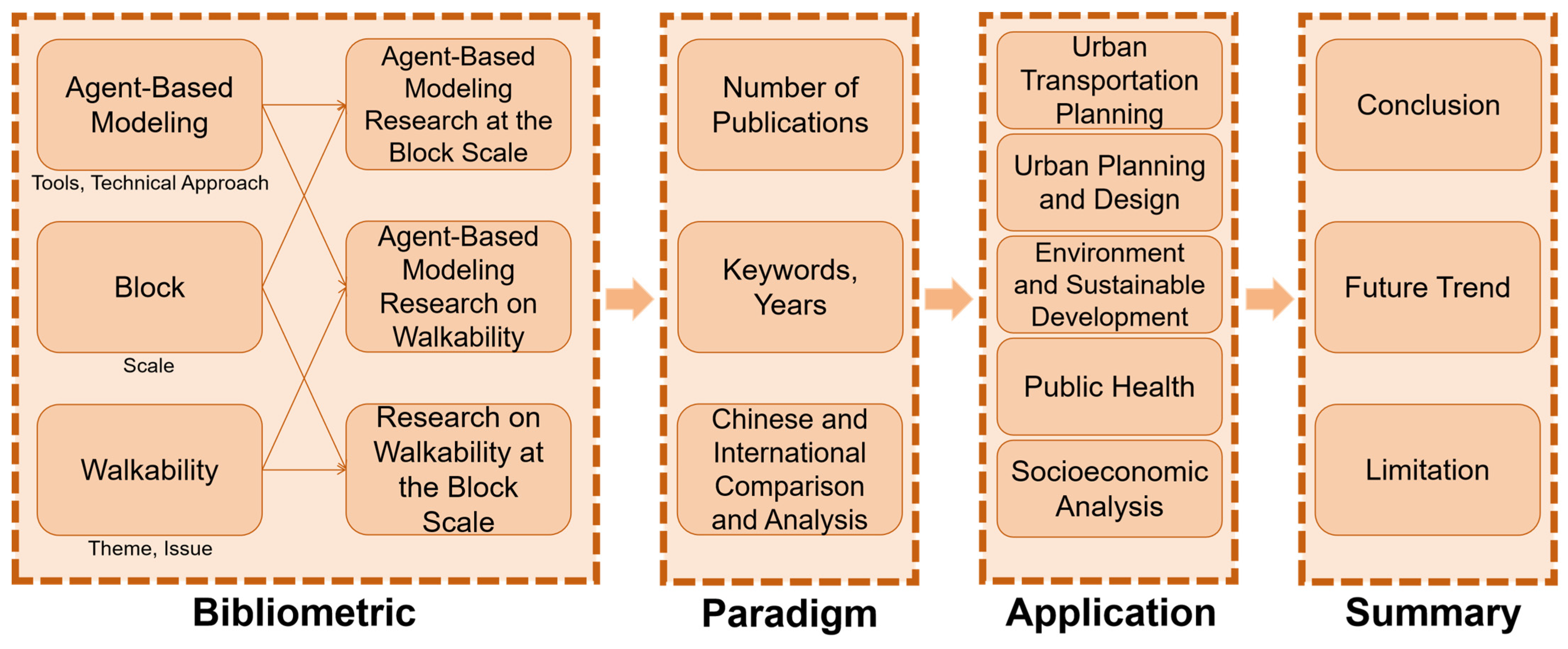

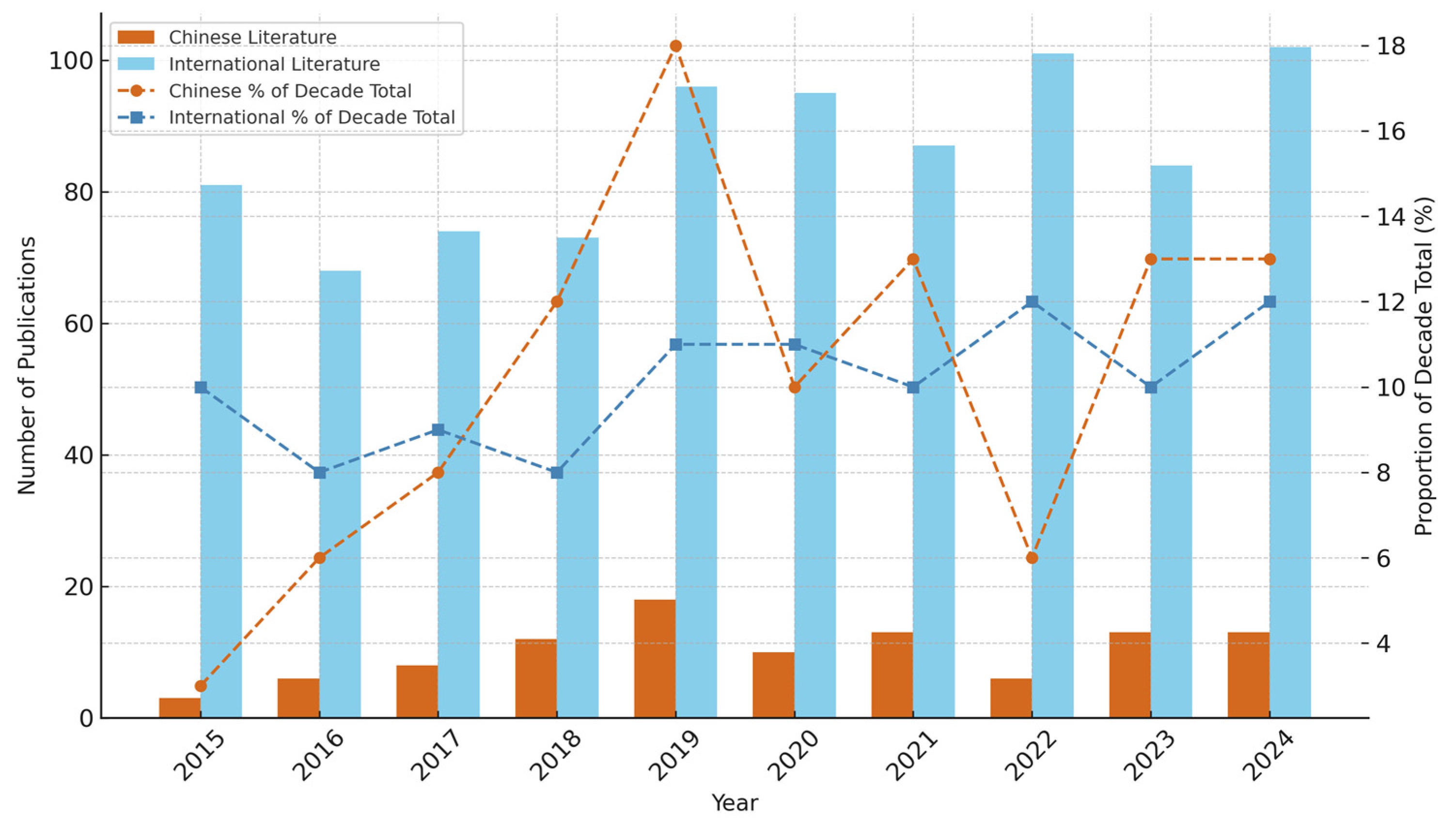
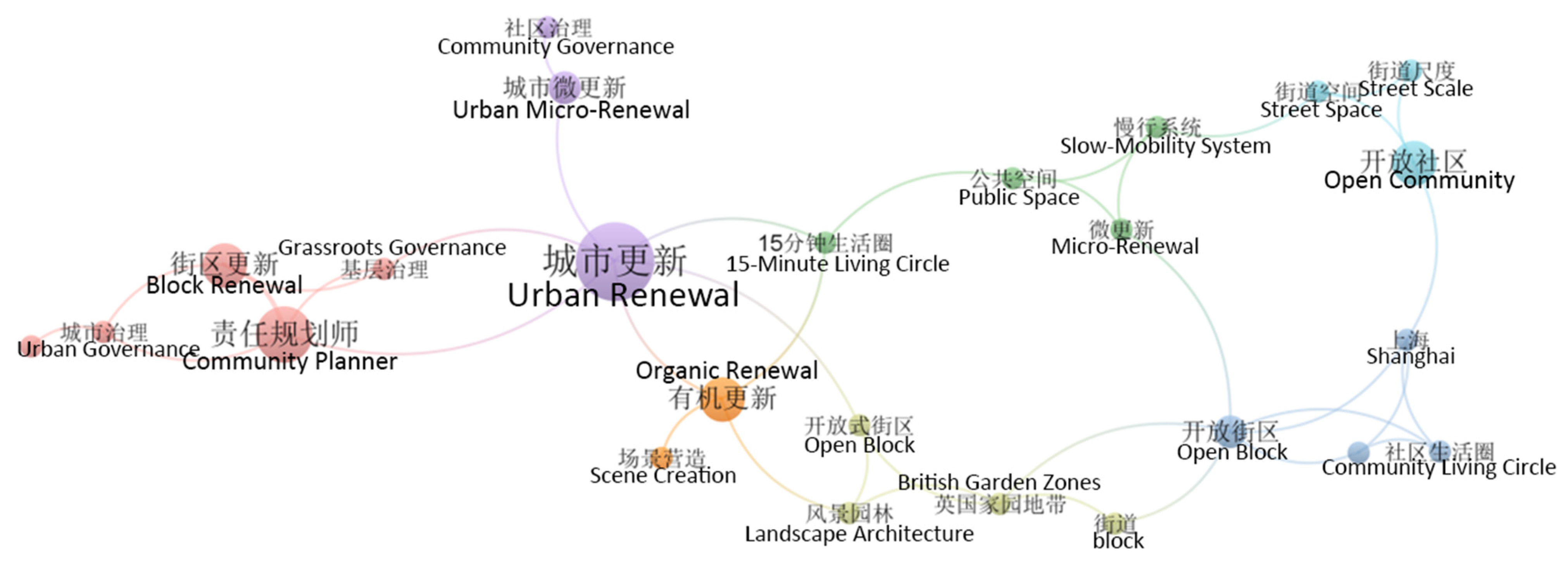
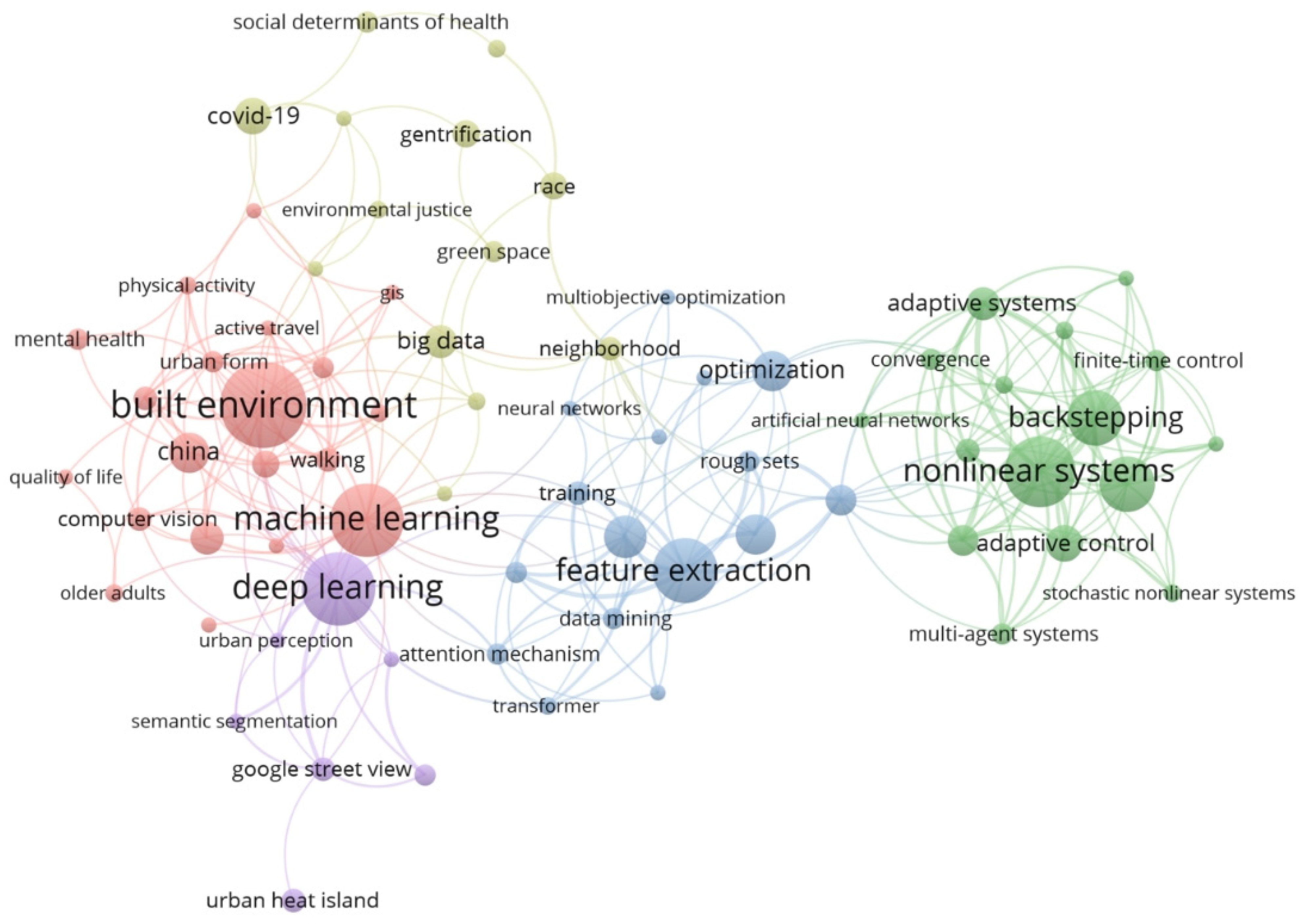
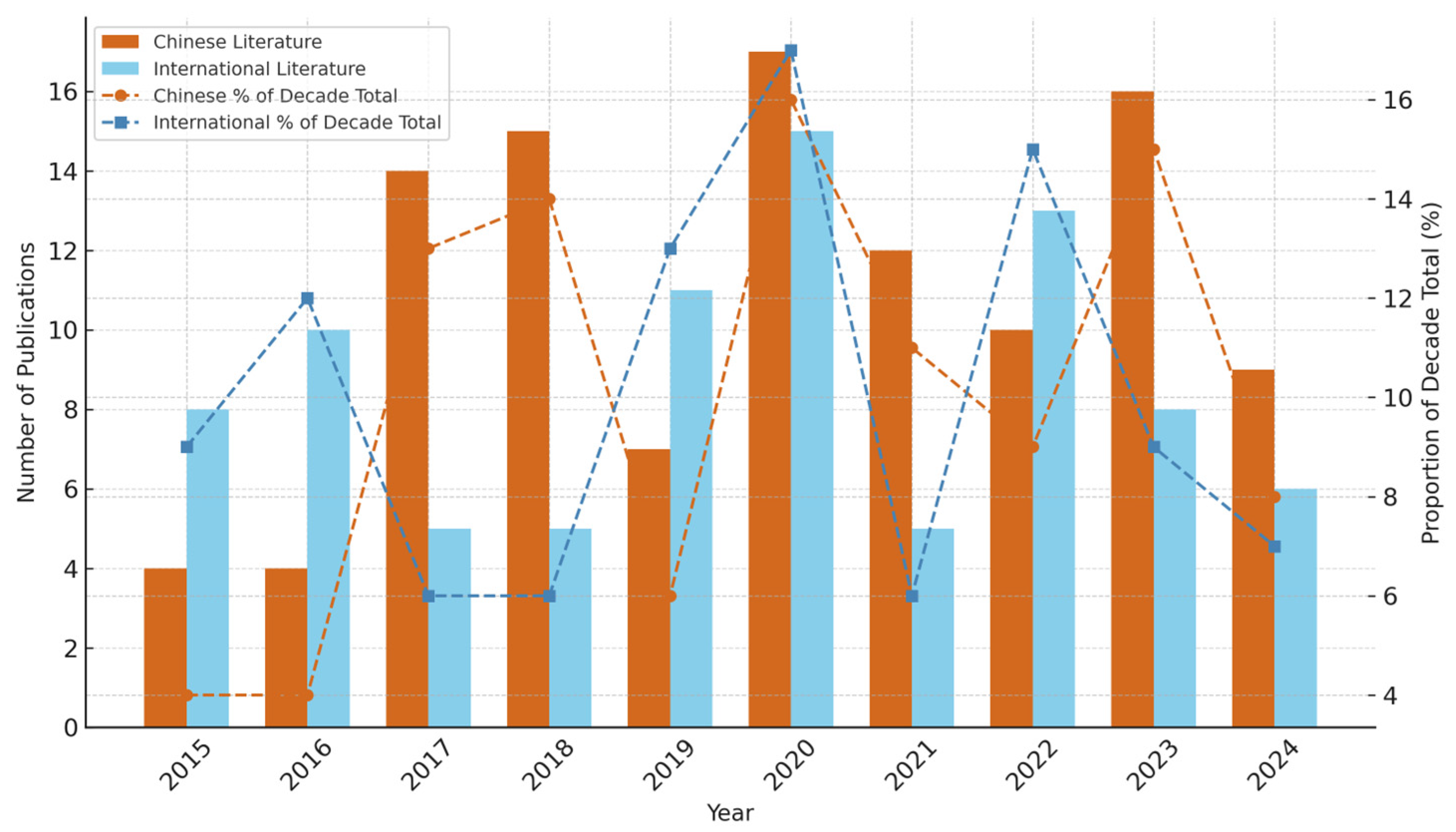
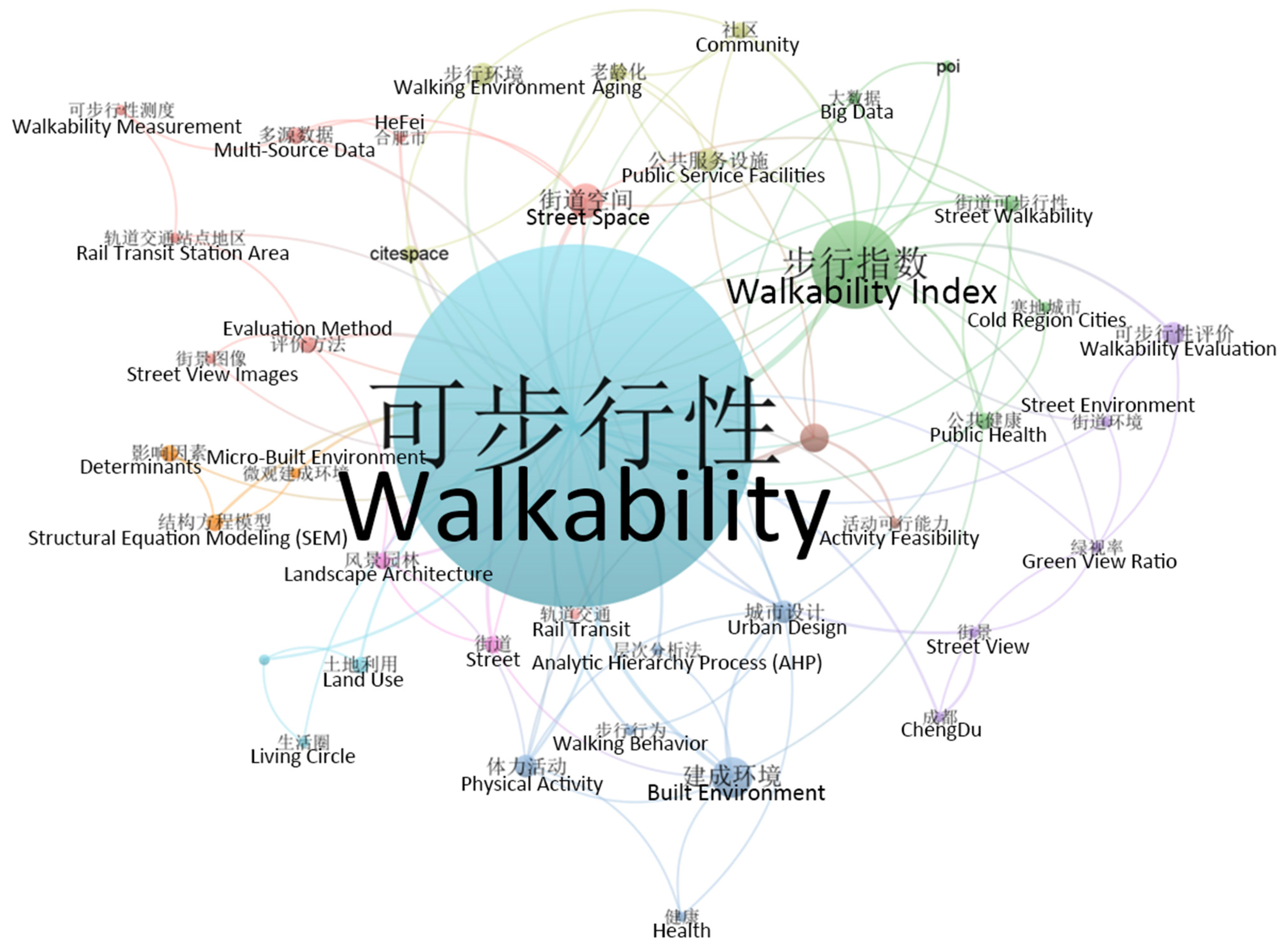
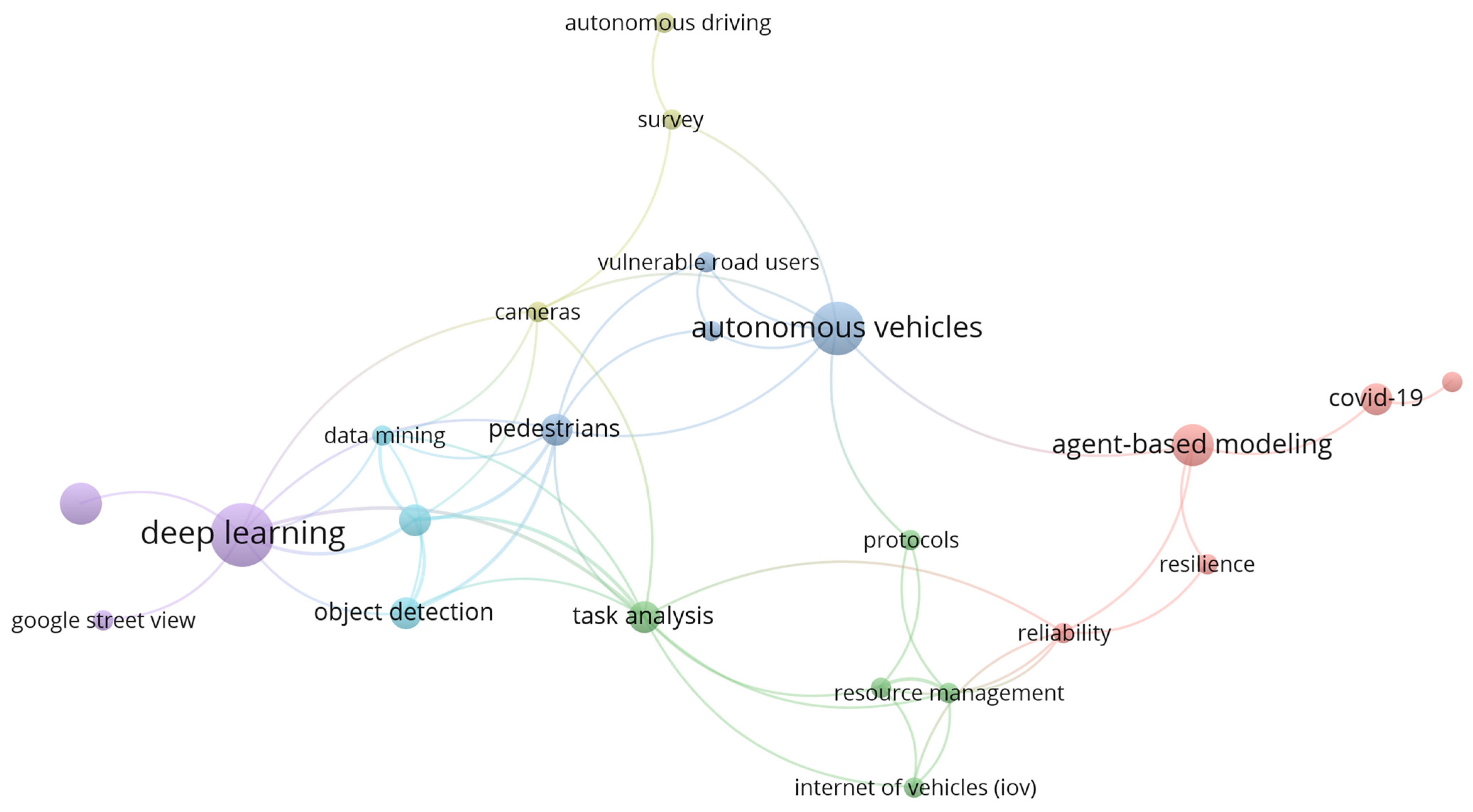
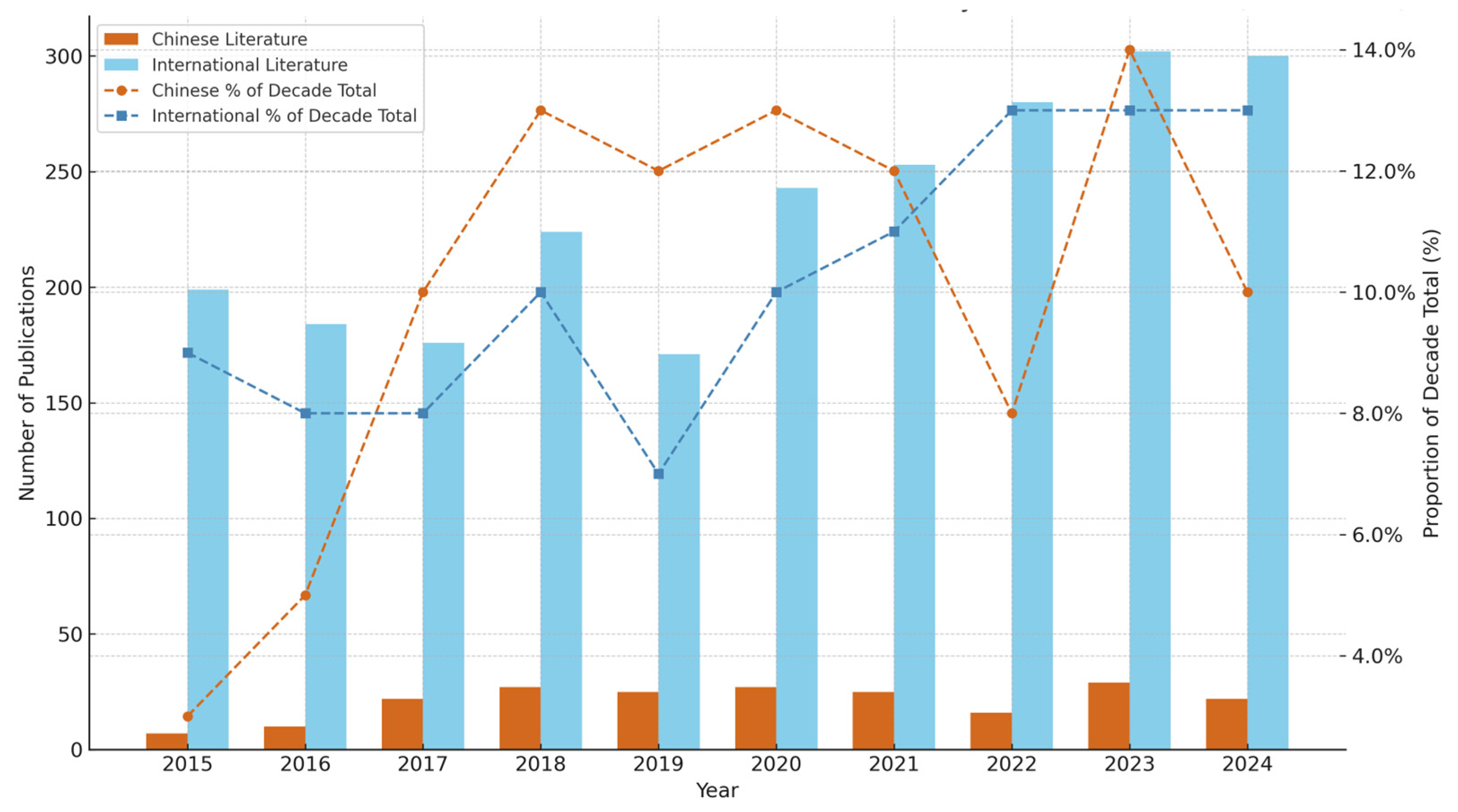
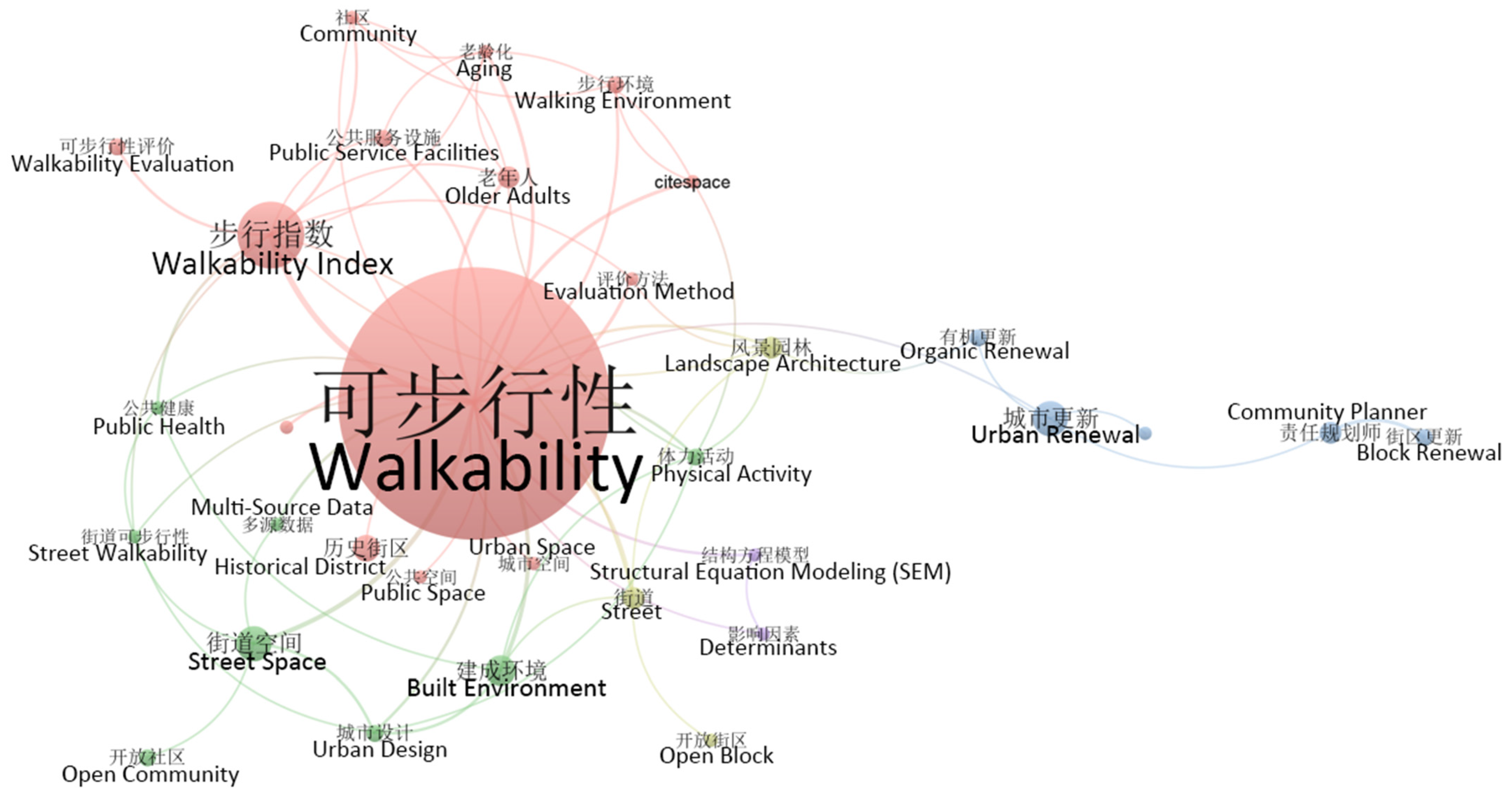
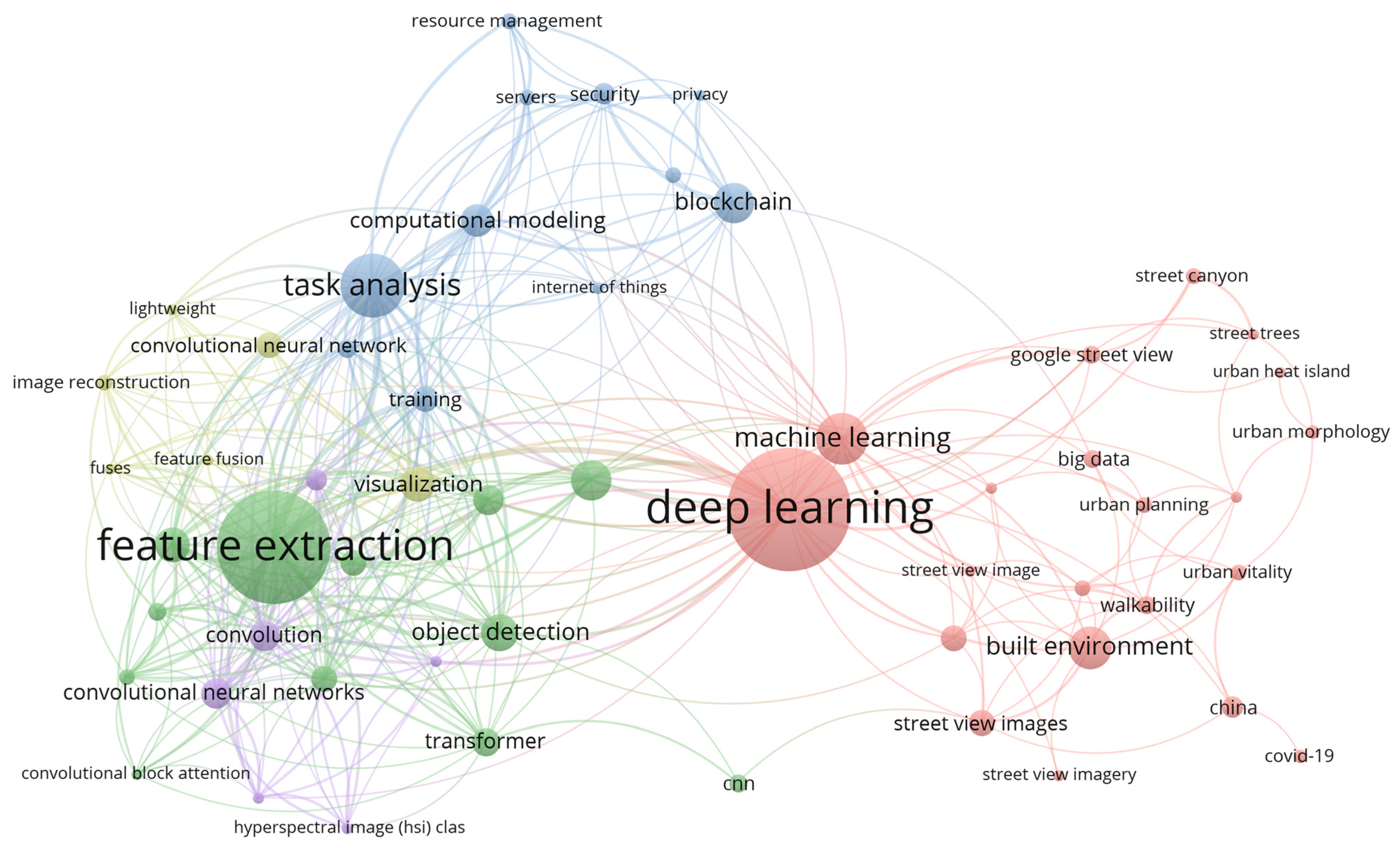
| Method | Advantages | Limitations | Applicable Scenarios |
|---|---|---|---|
| Survey Method | Captures individual perceptions and emotional experiences; low implementation cost | Prone to sampling bias; data validity relies on verification; limited in capturing interactive dynamics | Small-scale or community-level studies |
| Walkability Scoring | Provides objective measures; useful for comparative analysis; supports visualized outputs | Tends to overlook heterogeneity; limited sensitivity to micro-level variations | Urban planning and policy evaluation |
| ABM | Enables dynamic simulation; models behavioral interactions; supports parameterized experimentation | Requires extensive parameter calibration; involves high technical and computational cost | Complex block-level environments; emergency scenarios; dynamic simulations |
| Dimension | Chinese Research Hotspots | International Research Hotspots | Interpretive Insights |
|---|---|---|---|
| Data Analysis Methods | Land-use; Simulation Modeling | Pedestrian Dynamics; Data Assimilation | Chinese studies focus on land-use allocation and block-scale modeling; international work emphasizes micro-level behavior in complex, high-resolution networks. |
| Application Areas | Traffic Safety; Block Renewal | Evacuation Models; Intelligent Transportation | Chinese research aligns with policy-driven agendas, while international research prioritizes risk mitigation and system-wide transport innovation. |
| Technical Challenges | Model Simplification; Accuracy Trade-offs | Data Privacy; Ethical Regulations | Chinese models prioritize feasibility and implementation in large-scale urban systems; international studies highlight ethical concerns, user privacy, and regulatory compliance. |
Disclaimer/Publisher’s Note: The statements, opinions and data contained in all publications are solely those of the individual author(s) and contributor(s) and not of MDPI and/or the editor(s). MDPI and/or the editor(s) disclaim responsibility for any injury to people or property resulting from any ideas, methods, instructions or products referred to in the content. |
© 2025 by the authors. Licensee MDPI, Basel, Switzerland. This article is an open access article distributed under the terms and conditions of the Creative Commons Attribution (CC BY) license (https://creativecommons.org/licenses/by/4.0/).
Share and Cite
Wang, Y.; Wang, R.; Xu, X.; Zhang, B.; White, M.; Huang, X. Bridging Global Perspectives: A Comparative Review of Agent-Based Modeling for Block-Level Walkability in Chinese and International Research. Buildings 2025, 15, 3613. https://doi.org/10.3390/buildings15193613
Wang Y, Wang R, Xu X, Zhang B, White M, Huang X. Bridging Global Perspectives: A Comparative Review of Agent-Based Modeling for Block-Level Walkability in Chinese and International Research. Buildings. 2025; 15(19):3613. https://doi.org/10.3390/buildings15193613
Chicago/Turabian StyleWang, Yidan, Renzhang Wang, Xiaowen Xu, Bo Zhang, Marcus White, and Xiaoran Huang. 2025. "Bridging Global Perspectives: A Comparative Review of Agent-Based Modeling for Block-Level Walkability in Chinese and International Research" Buildings 15, no. 19: 3613. https://doi.org/10.3390/buildings15193613
APA StyleWang, Y., Wang, R., Xu, X., Zhang, B., White, M., & Huang, X. (2025). Bridging Global Perspectives: A Comparative Review of Agent-Based Modeling for Block-Level Walkability in Chinese and International Research. Buildings, 15(19), 3613. https://doi.org/10.3390/buildings15193613






